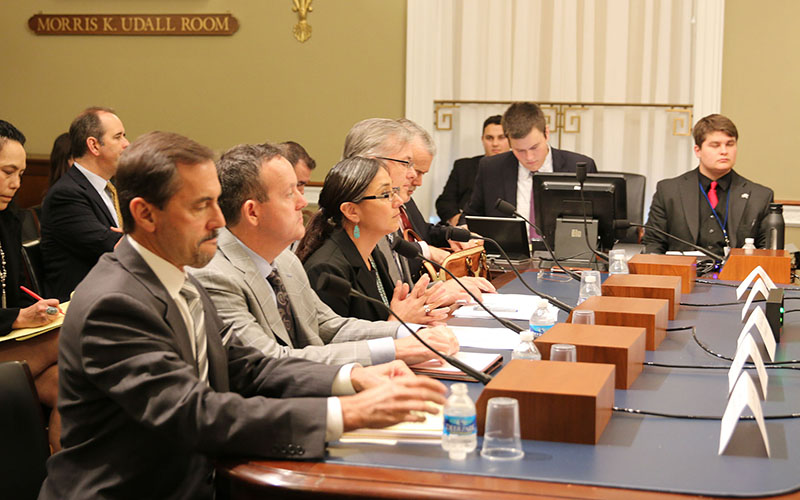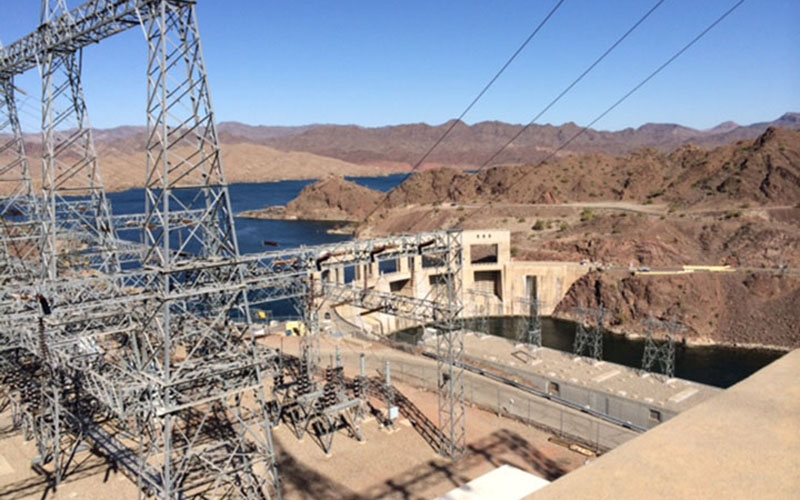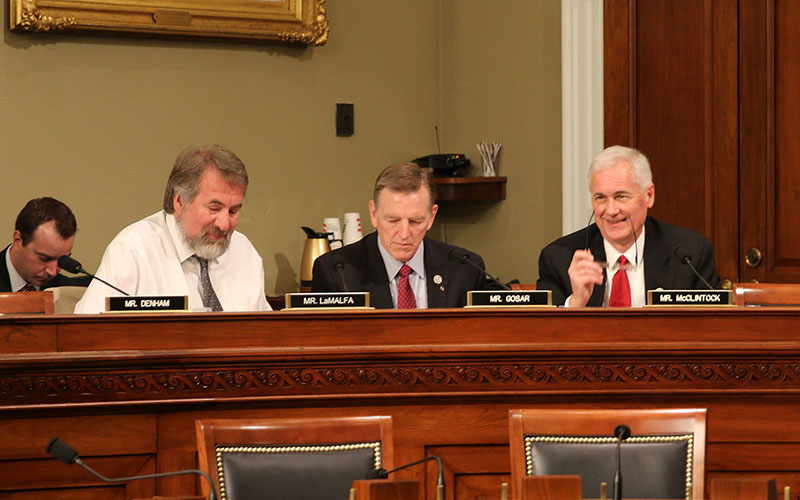
This Pinal County substation is part of the Western Area Power Administration network that tranmits electricity to more than 40 million people in 15 central and Western states, including Arizona. (Photo by Todd Rhoades/Western Area Power)

Western Area Power Administration interim Chief Financial Officer Dennis Sullivan, second from left, said his agency is committed to transparency after reports of lax spending oversight. (Photo by Joe Gilmore/Cronkite News)

The Parker Dam and Substation in Arizona, part of the Western Area Power Administration’s transmission grid. Questions have been raised about how well the federal agency oversees its spending. (Photo by Mark Gabiel/Western Area Power)

Rep. Paul Gosar, R-Prescott, center, is the lead sponsor of a bill that would require greater transparency from the Western Area Power Administration on how it spends and manages its money. (Photo by Joe Gilmore/Cronkite News)
WASHINGTON – A Western Area Power Administration official told a House subcommittee Thursday that he is committed to transparency at the agency, where audits found as much as $6.8 million in questionable purchases by employees in recent years.
Dennis Sullivan, interim chief financial officer for WAPA, was testifying in support of legislation that would require greater transparency from the agency that delivers power to more than 40 million people in 15 central and Western states, including Arizona.
The bipartisan bill – sponsored by Rep. Paul Gosar, R-Prescott, and co-sponsored by six other Arizona lawmakers – was introduced after rate increases that followed lax controls on spending and poor management of WAPA funds.
Gosar pointed to investigations that found WAPA’s government purchasing cards paid for $3,000 in ammunition and thousands more for specialized weapons and equipment for an agency whose “employees don’t have government-issued guns.” He said one employee spent $14,000 on an off-road vehicle, another employee amassed $50,000 a month in other questionable expenditures.
A March report by the Department of Energy, WAPA’s parent agency, said a 2014 audit of spending in WAPA’s Desert Southwest region found almost 2,500 questionable purchases by 74 cardholders totaling approximately $1.9 million. Later audits that looked at all four regions and the agency’s Western headquarters found a total of $6.8 million in purchases from December 2014 to October 2015 that merited further review.
The questionable spending comes as WAPA, which delivers power from 56 federally owned power plants, is increasing charges to customers.
Patrick Ledger, the CEO of Arizona Electric Generation and Transmission Cooperatives, told the House Natural Resources subcommittee Thursday that he has seen a 32 percent rate increase from WAPA over the past five years.
“The issue’s important because for the last 10 years or so we’ve seen WAPA cost increases year after year and we haven’t really gotten a straight answer” as to why, Ledger said.
As a nonprofit wholesale power transmission provider for more than 400,000 people in Arizona, California and New Mexico, Arizona Electric G&T is fully accountable to its members for its own cost increases, Ledger said. But when it comes to explaining WAPA charges, Ledger said he feels “underequipped.”
He said increased staffing and security concerns are driving up costs for many utilities, but his company has taken “bold steps” to streamline operations and keep rates as low as possible in its largely rural service area where many customers live below the poverty level.
“Why have Western (WAPA) rates increased?” Ledger asked. “I can’t answer this question because the answer is not readily available.”
That would change under the bill, which would require a public website where detailed accounts of WAPA rates, expenditures, staffing and other operational and financial dealings could be found easily.
“It ensures that transparency of the expenditures so that we know that we’re getting the lowest cost to the ratepayer and those are the consumers,” Gosar said after the hearing. “And it’s all about customer service and transparency, and that’s not been what we received in the past from WAPA.”
Sullivan told the subcommittee during his testimony that WAPA has already “proactively taken multiple steps to evolve and increase our transparency efforts and will continue to do so.”
When Gosar directly asked whether the agency supports the transparency legislation, Sullivan said it does.
“It’s aligned with our commitment to business excellence and sound business practices,” Sullivan said. “We are committed to sharing information openly and honestly.”
The 10 co-sponsors on the bill include Arizona Democratic Reps. Kyrsten Sinema of Phoenix and Tom O’Halleran of Sedona, and Republican Reps. Andy Biggs of Mesa, Trent Franks of Gilbert, Martha McSally of Tucson and David Schweikert of Fountain Hills.
Arizona Sens. John McCain and Jeff Flake have also introduced companion legislation in the Senate.
“This is not controversial as you can see,” Gosar said. “It’s based upon good customer service and allowing the consumer to actually know what they’re paying for.”
Ledger called the transparency bill “a good first step,” but said more needs to be done.
“We’re going to need leadership of WAPA to be better about sticking to their statutory mission … (operating) at the lowest possible cost,” he said.